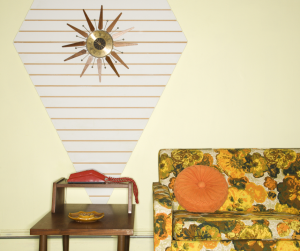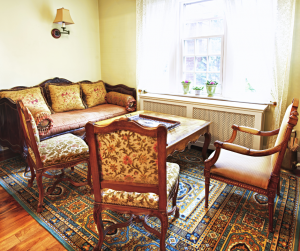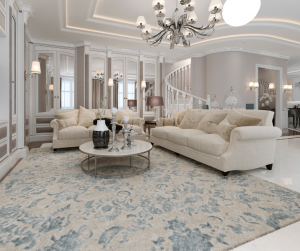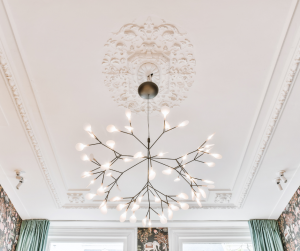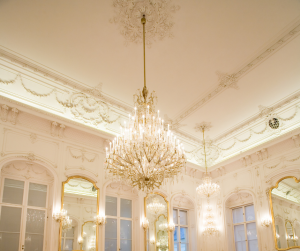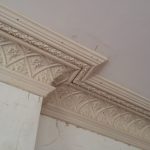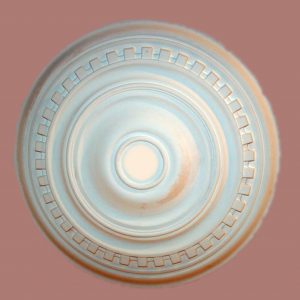Over the past century, the world of home decor has witnessed an incredible transformation, reflecting the changing tastes, trends, and societal shifts of each era. From the elegant plaster mouldings like cornice and ceiling centres to the diverse array of interior styles, decor, and furnishings, homes have evolved into personal sanctuaries that reflect individuality and cultural influences. Join us on a journey through time as we explore the fascinating evolution of home decor over the last 100 years.

1920s – The Roaring Twenties
The 1920s introduced an era of unprecedented opulence and exuberance in home decor. Inspired by the Art Deco movement, interiors featured bold geometric patterns, rich colors, and a fusion of traditional and modern influences. Plaster mouldings like cornices adorned the ceilings, adding grandeur to the rooms, while ceiling centers showcased intricate designs, emphasising the height of elegance.
1930s – The Art Moderne Era
As the world recovered from the Great Depression, the 1930s saw a shift towards simplicity and functionality in home decor. Inspired by the Art Moderne movement, clean lines, curved forms, and smooth surfaces took center stage. Plaster mouldings were streamlined, featuring sleeker designs, reflecting the modernist influence. Decor favored monochromatic color schemes, with an emphasis on minimalism and efficiency.
1940s – Post-War Rejuvenation
In the aftermath of World War II, the 1940s brought a sense of optimism and renewal. Homes became a sanctuary, reflecting comfort and coziness. Plaster mouldings retained their elegance, but with a touch of subtlety. Ceiling centers embraced organic motifs, mirroring the renewed interest in nature and the outdoors. Soft colors, floral patterns, and warm textures dominated the decor, creating a nurturing ambiance.
1950s – The Golden Age of Mid-Century Modern
The 1950s witnessed the rise of the iconic Mid-Century Modern style, characterised by clean lines, functionality, and a seamless integration of indoor and outdoor spaces. Plaster mouldings became simpler and more understated, aligning with the minimalist aesthetics of the era. Homes showcased open floor plans, natural materials, and iconic furniture designs, epitomised by Eames chairs and Noguchi coffee tables.
1960s – The Swinging Sixties
The 1960s marked a time of rebellion and experimentation, reflected in the bold and vibrant home decor of the era. Plaster mouldings took a backseat as homeowners embraced unconventional materials like plastic and fiberglass. Pop art-inspired prints and psychedelic patterns adorned walls, while shag carpets and bean bags added a touch of whimsy to interiors. The focus shifted to self-expression and breaking traditional design norms.
1970s – The Eclectic Era
The 1970s embraced eclecticism, as diverse cultures and global influences found their way into homes. Plaster mouldings made a comeback with intricate designs that paid homage to traditional craftsmanship. Bohemian decor gained popularity, with macramé wall hangings, rattan furniture, and earthy color palettes creating a relaxed and organic vibe. Homes became havens for self-discovery and self-expression.
1980s – The Era of Excess
The 1980s witnessed an era of excess and glamour in home decor. Plaster mouldings returned to their former glory, showcasing intricate details and elaborate designs. The rise of the “power suits” and bold fashion choices translated into interiors adorned with metallic finishes, mirrored walls, and oversized furniture. Rooms were filled with opulence, reflecting a desire for wealth and status.
1990s – The Age of Simplicity
In stark contrast to the previous decade, the 1990s embraced a more understated and minimalist approach to home decor. Plaster mouldings became more subdued, focusing on clean lines and simplicity. Neutral color palettes, natural materials, and sleek furniture defined the era. The concept of “less is more” dominated interior design, as homeowners sought to create serene and uncluttered spaces.
2000s – The Digital Revolution
The new millennium brought with it the rise of the digital age, which greatly influenced home decor trends. Plaster mouldings evolved to accommodate the integration of technology, featuring built-in wiring and smart home capabilities. Interiors became more tech-friendly, with sleek and minimalist designs. Modern aesthetics, such as Scandinavian and industrial styles, gained popularity, emphasizing functionality and efficiency.
The evolution of home decor over the last 100 years is a testament to the ever-changing tastes, influences, and cultural shifts that shape our lives. From the grandeur of plaster mouldings like cornice and ceiling centers to the diverse array of interior styles and furnishings, each era has left its mark on the way we design our homes. Its fascinating to imagine how our homes will continue to reflect blending tradition with innovation, and personal expression with functionality.
For more inspiration and ideas – follow our instagram @abbymouldingsltd



